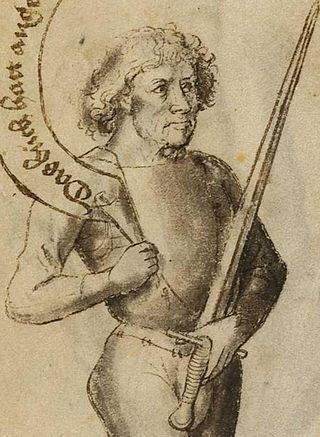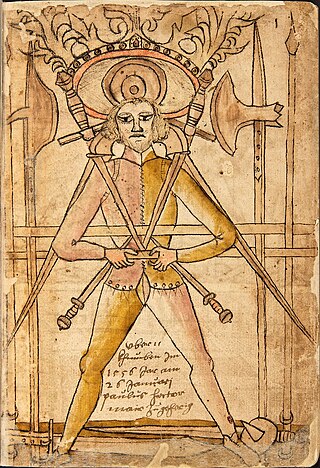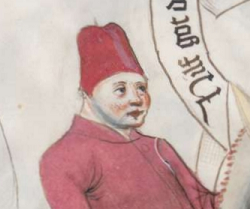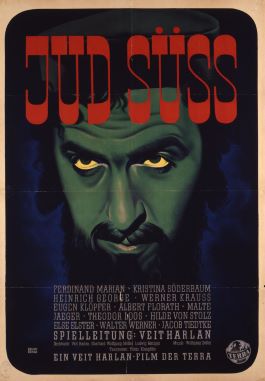Related Research Articles

A longsword is a type of European sword characterized as having a cruciform hilt with a grip for primarily two-handed use, a straight double-edged blade of around 80 to 110 cm, and weighing approximately 1 to 1.5 kg.

Hans Talhoffer was a German fencing master. His martial lineage is unknown, but his writings make it clear that he had some connection to the tradition of Johannes Liechtenauer, the grand master of a well-known Medieval German school of fencing. Talhoffer was a well-educated man who took interest in astrology, mathematics, onomastics, and the auctoritas and the ratio. He authored at least five fencing manuals during the course of his career, and appears to have made his living teaching, including training people for trial by combat.

Johannes Liechtenauer was a German fencing master who had a great level of influence on the German fencing tradition in the 14th century.

Codex 3227a of the Germanisches Nationalmuseum in Nuremberg is a manuscript of 169 folia, dated to the close of the 14th century. Its text is written in Latin and German. The German portions have been identified as in East Central German dialect.

Historical European martial arts (HEMA) are martial arts of European origin, particularly using arts formerly practised, but having since died out or evolved into very different forms.
Martial arts manuals are instructions, with or without illustrations, specifically designed to be learnt from a book. Many books detailing specific techniques of martial arts are often erroneously called manuals but were written as treatises.

The German school of fencing is a system of combat taught in the Holy Roman Empire during the Late Medieval, German Renaissance, and early modern periods. It is described in the contemporary Fechtbücher written at the time. The geographical center of this tradition was in what is now Southern Germany including Augsburg, Frankfurt, and Nuremberg. During the period in which it was taught, it was known as the Kunst des Fechtens, or the "Art of Fighting". The German school of fencing focuses primarily on the use of the two-handed longsword; it also describes the use of many other weapons, including polearms, medieval daggers, messers, and the staff, as well as describing mounted combat and unarmed grappling (ringen).

Sigmund Schining ein Ringeck was a German fencing master. While the meaning of the surname "Schining" is uncertain, the suffix "ain Ringeck" may indicate that he came from the Rhineland region of south-western Germany. He is named in the text of his treatise as Schirmaister to one Duke Albrecht, Count Palatine of Rhine and Duke of Bavaria. Other than this, the only thing that can be determined about his life is that his renown as a master was sufficient for Paulus Kal to include him on his memorial to the deceased masters of the Society of Liechtenauer in 1470. Ringeck seems to have authored one of the few complete glosses of the epitome of the grand master Johannes Liechtenauer, making him one of the most important German fencing masters of the 15th century.

Paulus Kal was a 15th-century German fencing master. According to his own testimony, he was the student of one Hans Stettner, who was in turn an initiate of the tradition of Johannes Liechtenauer. He served as fencing master at three different courts in his career, serving in various military capacities including commanding men in at least three campaigns. Perhaps his most significant legacy is an honor role of deceased masters included in the Bologna and Munich versions of his treatise, which he styled the Society of Liechtenauer. While several of these masters remain unknown, the majority wrote treatises of their own and Kal's list stands as an independent confirmation of their connection to the grand master. Kal's treatise is also interesting in that it represents the first attempt to give pictorial illustrations for parts of Liechtenauer's tradition of fencing.

The Rhineland massacres, also known as the German Crusade of 1096 or Gzerot Tatnó, were a series of mass murders of Jews perpetrated by mobs of French and German Christians of the People's Crusade in the year 1096, or 4856 according to the Hebrew calendar. These massacres are often seen as the first in a sequence of antisemitic events in Europe which culminated in the Holocaust.

Cod. 44 A 8 also known as MS 1449, Bibliotheca dell'Academica Nazionale dei Lincei e Corsiniana, is a Fechtbuch compiled by Peter von Danzig in 1452. Danzig was a 15th-century German fencing master. He was counted among the 17 members of the "society of Johannes Liechtenauer".

Ringen is the German language term for grappling (wrestling). In the context of the German school of historical European martial arts during the Late Middle Ages and the German Renaissance, Ringen refers to unarmed combat in general, including grappling techniques used as part of swordsmanship.

Joachim Meyer was a self-described Freifechter living in the then Free Imperial City of Strasbourg in the 16th century and the author of a fechtbuch Gründtliche Beschreibung der Kunst des Fechtens first published in 1570.
Ferdinand Heinrich Johann Haschkowetz, known by the stage name Ferdinand Marian, was an Austrian actor. Though a prolific stage actor in Berlin and a popular matinée idol throughout the 1930s and early '40s, he is best remembered for playing the lead role of Joseph Süß Oppenheimer in the notorious Nazi propaganda film Jud Süß (1940).

Wrestling and grappling sports have a long and complicated history, stretching into prehistoric times. Many traditional forms survive, grouped under the term folk wrestling. More formal systems have been codified in various forms of martial arts worldwide, where grappling techniques form a significant subset of unarmed fighting.

Jud Süß is a 1940 Nazi German historical drama and propaganda film produced by Terra Film at the behest of Joseph Goebbels. It is considered one of the most antisemitic films of all time. The film was directed by Veit Harlan, who wrote the screenplay with Eberhard Wolfgang Möller and Ludwig Metzger. The leading roles were played by Ferdinand Marian and Harlan's wife Kristina Söderbaum; Werner Krauss and Heinrich George played key supporting roles.
Brian R. Price is an American university professor, historical fencing instructor, and member of the Society for Creative Anachronism. He taught at Hawai'i Pacific University, until some time before Nov. 11, 2022, when he was not listed among the faculty there. As of Nov. 10, 2022, Price is listed as "an Associate Professor in the Department of Joint Warfighting at the Air Command and Staff College", Air University at Maxwell AFB in Alabama

The Glasgow Fechtbuch is a combat manual of the German school of fencing, dated to 1505. Consisting of 105 folia, it combines the instructions of various masters of the 15th century who stood in the tradition of Johannes Liechtenauer, presumably based on a previous compilation made by fencing master Sigmund Schining ein Ringeck.
Chivalry Bookshelf was a small press based in the United States founded by Brian R. Price which published booklets and books from 1992 to 2007. It was most notable for its contributions to the Society of Creative Anachronism and the early historical fencing movement and for a dispute about plagiarism and nonpayment of royalties in 2011-12.
Trust No Fox on his Green Heath and No Jew on his Oath! A Picture Book for Old and Young is an antisemitic children's picture book published in November 1936 in Nazi Germany. The book was written and illustrated by Elvira Bauer, a kindergarten teacher, art student, and Nazi supporter. It was the first of three children's books to be published by Julius Streicher, the editor of the infamously antisemitic newspaper Der Stürmer, who was later executed for war crimes.
References
- ↑ "Neuerdings hat Ginsburger ('Les Juifs et l'art militaire' in REJ 87 [1929]) nachgewiesen, daß der herzoglich österreichische Ringmeister 'Ott Jud' ein Judentäufling war. Aber ob das wirklich als 'preuve presque certaine' aufgefaßt werden darf, daß der von G. erwähnte Autor eines Buches über Fechtkunst namens Andreas Jude ebenfalls jüdischer Abkunft war, erscheint mir zweifelhaft." Zeitschrift für die Geschichte der Juden in Deutschland, vol. 3 (1931).
- Lindholm, David and Svard, Peter. Sigmund Ringeck's Knightly Arts of Combat. Boulder, CO: Paladin Press, 2006. ISBN 978-1-58160-499-3
- Tobler, Christian Henry. In Saint George's Name: An Anthology of Medieval German Fighting Arts. Wheaton, IL: Freelance Academy Press, 2010. ISBN 978-0-9825911-1-6
- Tobler, Christian Henry. Secrets of German Medieval Swordsmanship. Union City, Calif.: The Chivalry Bookshelf, 2001. ISBN 1-891448-07-2